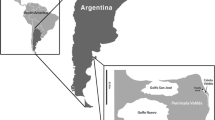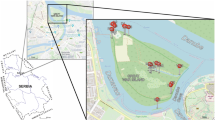Abstract
An assessment of the diversity and abundance of macrobenthic community in a refined-oil (petrol) impacted and fire-ravaged mangrove ecosystem within the vicinity of a marine receipt terminal facility (Atlas Cove) serving as a distribution and pump station for refined products was carried out. The mangrove ecosystem was subjected to massive petrol spillage from a leaking pipeline and eventual fire outbreak. Following rehabilitation activities, a recovery assessment of the impacted ecosystem was carried out. The field surveys revealed that the petrol leakage and fire outbreak resulted in a near complete destruction of the mangrove ecosystem around the Atlas Cove depot, with macrobenthic species diversity index ranging between 0−0.4, compared to 0.78−0.87 in the control stations. The dominant early arrivals or colonizers of the impacted stations areas were Clibanarius africanus and Callinectes amnicola. Early signs of recovery of the impacted area were observed within about two and a half (2 1/2) to three (3) months, based on diversity and abundance indices respectively. The period of early signs of recovery also coincide with an observed reduction in the total hydrocarbon content (THC) levels in the sediment collected from the impacted stations by about nine folds from 3.67 mg/kg to 0.42 mg/kg within 3 months. Despite the apparent signs of recovery, the need for long-term monitoring of the impacted stations was discussed.
Similar content being viewed by others
References
Adubi, F.A. (1995). The Impact of the Pipeline Interlink on the Distribution of Refined PetroleumProducts in Nigeria. An Address delivered at NNPC/Government Relations Forum for Directors and Chief Executives ofGovernment Parastatals, pp. 15.
APHA-AWWA-WPCF. (1995). Standard methods for the examination of water and waste water (16th Edn.).American Public Health Association.
Dwire, K.A., & Kauffman, J.B. (2003). Fire and riparian ecosystems in landscapes of the western USA. Forest Ecology and Management, 178, 61–74.
Hawkins, S.J., Gibbs, P.E., Pope, N.D., Burt, G.R., Chesman, B.S., Bray, S., Proud, S.V., Spence, S.K., Southward, A.J., & Langston, W.J. (2002). Recovery of polluted ecosystems: the case for long-term studies. Marine Environmental Research, 54, 215–222.
Lakly, M.B., & McArthur, J.V. (2000). Macroinvertebrate recovery of a post-thermal stream: habitatstructure and biotic function. Ecological Engineering, 15, S87–S100.
Margalef, F. (1951). Diversidad de especies es las Communidades Naturales, Publnes. Institute ofBiological Apl., Barcelona, 6, 57–72.
Minshall, G.W. (2003). Responses of stream benthic macroinvertebrates to fire. Forest Ecology andManagement, 178, 155–161.
Nigerian National Petroleum Corporation (NNPC). (1983). Products, pipelines and depots system (pp. 11).NNPC: Public Affairs Department.
Otitoloju, A.A. & Are, T (2003). Tolerance: A useful biological parameter for identifying contaminatedsites. Bulletin of Environmental Contamination and Toxicology, 71, 1139–1144.
Otitoloju, A.A., & Don-Pedro, K.N. (2004). Integrated laboratory and field assessments of heavy metalsaccumulation in edible periwinkle. Tympanotonus fuscatus var adula (L.). Ecotoxicology and EnvironmentalSafety, 57, 354–362.
Peterson, C.H. (2001). The Exxon Valdes spill in Alaska: Acute, indirect and chronic effects on theecosystem. Advances in Marine Biology, 39, 1–103.
Peterson, C.H. & Eates, J.H. (2001). Conservation and management of marine communities. In M.D.Bertness, S.D., Gaines, M.E., Hay (Eds.) Marine Community (pp. 469–507). Sunderland: Ecology, Sinauer Associates.
Petroleum and Products Marketing Company (PPMC) Profile. (2001). Lagos: Public Affairs Department, PPMC, pp.1–10.
Southwood, A.J., & Southward, E.C. (1978). Recolonisation of rocky shores in cornwall after the use oftoxic dispersants to clean up the Torrey Canyon spill. Journal of Fishery Research Board of Canada, 35,682–706.
The Comet (Friday, December 1, 2000). 60 Dead in Lagos Pipeline Fire, 2,(519), 1–2.
This Day (2000). Scores Feared Dead in Lagos Pipeline Fire, Friday, December 1, 1 & 4.
Underwood, A. (1994). On beyond BACI: sampling designs that might reliably detect environmentaldisturbances. Ecological Applications, 4, 3–15.
Wallace, J.B., Eggert, S.L., Meyer, J.L. & Webster, J.R. (1999). Effects of resource limitation ondetrital-based ecosystem, Ecological Monographs, 69, 409–442.
Wolfgang, S. (1992). Guide De Terrain Des Resources Marines Commerciales du Golfe de Guinée (pp.281). FAO, Rome.
Yamamoto, T., Nakaoka, M., Komatsu, T., Kawai, H. (2003). Marine Life Research Group of Takeno and Ohwada, K. Impacts by heavy-oil spill from the Russian tanker Nakhodka on intertidal ecosystems: recovery of animal community.Marine Pollution Bulletin, 47, 91–98.
Author information
Authors and Affiliations
Corresponding author
Rights and permissions
About this article
Cite this article
Otitoloju, A.A., Are, T. & Junaid, K.A. Recovery assessment of a refined-oil impacted and fire ravaged mangrove ecosystem. Environ Monit Assess 127, 353–362 (2007). https://doi.org/10.1007/s10661-006-9285-7
Received:
Accepted:
Published:
Issue Date:
DOI: https://doi.org/10.1007/s10661-006-9285-7




